Is the plane that is contacting the control tower really the one that it claims to be? In order to check this, ONERA and its partners are developing a recognition system based on the use of ambient waves.
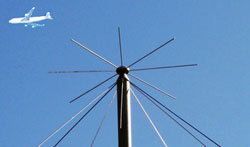
In the frame of this experiment, a receiver antenna checks
aircrafts near Paris-Orly airport. The device is located
on the roof of an Onera building in Palaiseau.
To check the identity of a person, all that is needed is to ask for his or her ID. And to know which aircraft is due to land soon, the air traffic controller must make do with ... asking the pilot. As surprising as it may seem, checking the identity of an aircraft is based solely on trust. That is why Onera, in partnership with Supelec and with two institutions in Singapore, has launched an aircraft recognition project within the framework of the Sondra laboratory, based on the use of passive radar.
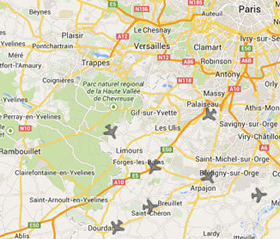
The experimental area of the passive radar
is the southern approach zone of Paris-Orly airport
Like the wolf that covers its paw with flour to pass itself off as the goat in the story of The Wolf and the Seven Kids, a pilot with bad intentions can easily insert his or her plane into air traffic, by passing it off as another plane. For example, a small plane can pass off as a large plane without the authorities noticing. In order to check that it is indeed the plane that it was declared to be, the collaborating researchers are proposing to use radar waves that are already present in the environment due to television, radio and mobile phone transmitter antennas, etc. "This detection by means of ‘passive radar’ does not require any authorization, which we would have had to obtain if we had set up our own radar transmitter” says Sylvain Azarian, who is in charge of this project called Automatic Target Recognition.
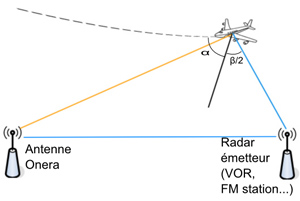
The passive antenna receives the signal from the ground transmitter through both direct path and reflection on the aircraft
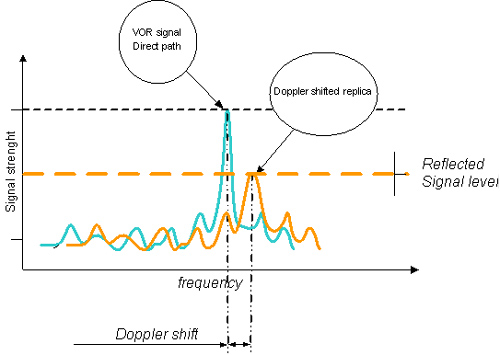
The frequency of the signal reflected by the plane is shifted (Doppler effect due to velocity). Signal strength depends on the shape and size of the aircraft.
By reflecting off the aircraft, these waves become deformed according to the shape of the plane. The latter can be determined by comparing these radio signals when the plane is present and when it isn’t, and it can even be recognized as long as it can be compared to a database containing the radar signatures for each type of aircraft. Usually, this database is not based on the actual signal of the aircraft, but rather on calculations made from the technical characteristics of the aircraft (size, shape, etc.)."What makes our approach original, is that this database is being created based on real aircraft in real situations: we recorded radar signals for everything taking off and landing at Orly airport for around ten days”, says Sylvain Azarian. “Since we had access to the identity of each plane, we were able to assign types of signal to types of aircraft".
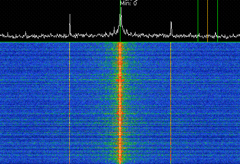
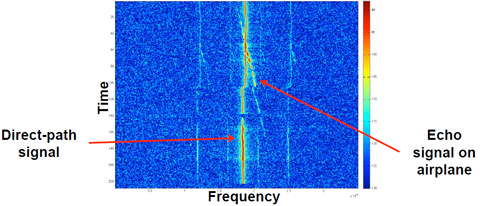
On the PC monitor, the spectrum (frequency distribution) is shown as a function of elapsed time. Above, the red vertical line represents the signal of the radar transmitter (completely stable). Below, the backslash betrays the passage of an aircraft - this is its signature. The slope information is about its velocity, the color about the electromagnetic energy returned.
Up to now, this method is only able to classify aircraft by size: small, medium or large, with a success rate of 95%. "This may seem little, but it allows airliners to be distinguished from fighter jets, for example, or a small plane hidden behind a large one to be identified”, says the researcher. “An aircraft that isn’t responding to the controller, or one that has deviated from its normal course in an air corridor, can also be detected and the alarm can be raised". The goal is of course to improve security, by anticipating possible terrorist attacks.
The advantage of this method is its self-learning aspect. For example, if a new plane comes onto the market, the recognition system will at first consider it as an unknown aircraft, before including it in the database if its "signature" indeed corresponds with the identification signal that it is transmitting (which it would in all cases, if everything is normal). This technique can be adapted to any airport. However, since radar transmitters are arranged differently in each place, it takes the software about ten days of learning to become operational.
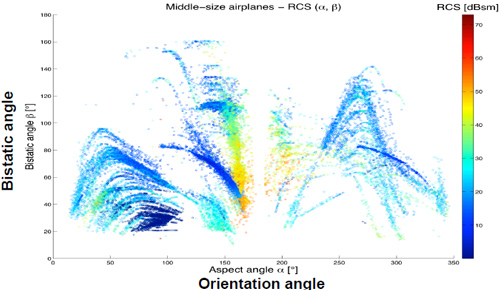
A database keeps track of all aircraft and classifies them according to their type (here medium size), thanks to their radio identification (ADS-B). Once this base sufficiently informed, the software can alert immediately the passage of an aircraft whose signature would be incompatible with its identification signal.
Beyond the interest of this automatic recognition system for security purposes, it is also perfect for... demonstrating the capabilities of Onera and Supelec. Indeed, for practical reasons, all 24h/24 data acquisitions can be controlled remotely via the Internet. French researchers were thus able to demonstrate the concept and to distinguish planes taking off or landing at Orly in real-time! "Disturbances can be seen, they are highly visible and very clear, even to someone who knows nothing about radar” says Sylvain Azarian enthusiastically.
The people in charge of the project are currently holding talks with a French company specializing in radar, to industrialize this technique. “We have shown that our recognition strategy works; the rest is up to the industry” says the researcher.
Attention amateurs!
Cécile Michaut, science journalist
Images ©Onera




